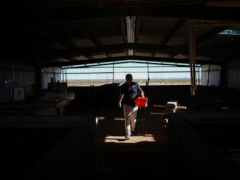DATELAND, Ariz. — Storks scatter, white against blue water, as Dan Mohring’s pickup truck rumbles down the dirt road. He’s towing a trailer full of ground-up beef, chicken, fish and nutrient bits behind him, ready to be shot out of a cannon into the ponds below.
It’s time to feed the fish.
Mohring fires up the machine and the food flies out in a rainbow arc. Then the water comes alive. Hundreds of thrashing, gobbling barramundi wiggle their way to the surface, all fighting for a piece. Until, in a few months, they will become food themselves.
In the desert of landlocked Arizona, where the Colorado River crisis has put water use under a microscope, Mainstream Aquaculture has a fish farm where it’s growing the tropical species barramundi, also known as Asian sea bass, for American restaurants.
Mainstream sees it as a sustainable alternative to ocean-caught seafood. They say chefs and conscious consumers like that the food has a shorter distance to travel, eliminating some of the pollution that comes from massive ships that move products around the world. And they and some aquaculture experts argue it’s efficient to use the water twice, since the nutrient-rich leftovers can irrigate crops like Bermuda grass sold for livestock feed.
“We’re in the business of water,” said Matt Mangan, head of Australia-based Mainstream’s American business. “We want to be here in 20 years’, 30 years’ time.”
But some experts question whether growing fish on a large scale in an arid region can work without high environmental costs.
That question comes down to what people collectively decide is a good use of water. In Arizona, some places manage water more aggressively than others. But the whole state is dealing with the impacts of climate change, which is making the region drier and water only more precious.
The farm uses groundwater, not Colorado River water. It’s a nonrenewable resource, and like mining, different people and industries have different philosophies about whether it should be extracted.
“As long as groundwater is treated as an open resource in these rural parts of Arizona, they’re susceptible to new industries coming in and using the groundwater for that industry,” said Sarah Porter, director of the Kyl Center for Water Policy at Arizona State University’s Morrison Institute.
Some scientists believe aquaculture can play a role in protecting wild ocean ecosystems from overfishing. And it might play at least a small role in smoothing any supply problems that result from the Trump administration’s tariffs on imports from dozens of countries, including those that send the U.S. about 80% of its seafood, per the United States Department of Agriculture.
In the greenhouses at University of Arizona professor Kevin Fitzsimmons’ lab in Tucson, tilapia circle idly in tanks that filter down into tubs full of mussels and floating patches of collard greens and lettuce. Fitzsimmons mentored the student who started the tilapia farm eventually bought by Mainstream about three years ago where they now raise barramundi.
“I don’t think desert agriculture is going away,” he said. “Obviously, we want to do it as water-efficient as possible.”
But not everyone agrees it’s possible.
“Artificial ponds in the d




